
It’s nothing new that the African continent is more vulnerable to crises than other parts of the world (the Western world in particular). This is also true for the most talked-about problem of climate change, which challenges countries that have few means to respond either because of a lack of money or because of their unstable socio-political conditions. According to a 2021 report of the World Meteorological Organization the number of climate-induced natural disasters have steadily increased every decade from 1970-1979 (WMO 2021). Madagascar, Zimbabwe and Mozambique, which in 2019 has experienced two of the strongest and most dangerous tornadoes of African history, have been classified as some of the most vulnerable countries to climate worldwide (Eckstein, D., Künzel, V et al. 2021).
As Africa as a whole emits only less than 4% of the total carbon dioxide worldwide (Tiseo, I. 2021), the continent’s struggle towards climate resilience is extremely unfair. For this reason, in recent years climate cooperation started to become ever more important in international cooperation. The European Union, which is very committed to the challenge against climate change, wasn’t late in creating a new channel of cooperation with Africa on climate. The first traces of climate cooperation can be tracked in the first strategy devised under the EU-AU partnership, the Joint Africa-EU Strategy (JAES) 2008-2010. At that moment the cooperation on climate change between the continents was still embryonic but was a good first start (Africa-EU partnership n.d). After that, the climate cooperation between EU and Africa did not step up sufficiently its commitments while climate change became an increasing problem affecting migrations, health, conflicts, not to mention countries’ GDP.
On 17th and 18th February Brussels hosted the 6th EU-AU Summit, a long-awaited forum between the two organisations that was repeatedly postponed due to the pandemic. The aim of the summit was to overhaul the partnership to make it more ambitious and create equitable and mutual opportunities in many fields, from energy, to migration and peace and security. The meeting between the 40 representatives of African countries and the EU was in the spotlight also because of the expected new commitments in the climate sector, after the EU launched its European Green Deal, which includes an external action. Also, on 9th March 2020 expectations were raised by the presentation of a new European strategy towards Africa, the “Comprehensive Strategy with Africa” which among its priorities stood out a “Partnership for green transition and energy access”.
All the hype for a new climate deal was dampened by the outcomes of both the Glasgow COP26 and the summit. During COP26 the EU failed to speak with one single voice not succeding in supporting Africa’s requests for help for, e.g., the “loss and damage” facility (Knaepen, H. 2021). During the 6th summit the EU failed to listen to African priorities. In particular, the EU while rightly recognising “that Africa’s energy transition is vital for its industrialisation and to bridge the energy gap” (African Business 2022), didn’t say anything in response to the request of the President of Senegal and the Chairperson of the AU, Macky Sall to maintain the financing of the gas industry needed by the continent to accelerate the economic development and industrialisation. What the conference lacked was also a discussion about the EU’s climate finance which is still not adequate in both quantitative and qualitative terms (Climate Action Tracker 2021).
Despite everything, the EU-AU climate agenda is still advancing and the two continents must not fail to take the chance of standing united in the next African COP27, creating new opportunities to finalise the work that has been slowly carried out in the last two decades.
References
Africa-EU partnership (n.d). The Partnership and Joint Africa-EU Strategy, Available at: https://africa-eu-partnership.org/en/partnership-and-jointafrica-eu-strategy (Accessed: 22/02/2022).
African Business (2022). Will EU-AU summit reshape Europe-Africa relations?, Available at: https://african.business/2022/02/trade-investment/will-eu-au-summit-reshape-europe-africa-relations/ (Accessed: 22/02/2022).
Climate Action Tracker (2021). EU, Available at: https://climateactiontracker.org/countries/eu/ (Accessed: 22/02/2022).
Eckstein, D., Künzel, V. and Schäfer, L. (2021). Global Climate Risk Index 2021. Who Suffers Most from Extreme Weather Events? Weather-Related Loss Events in 2019 and 2000-2019, Bonn, Germanwatch.
Knaepen, H. (2021). COP26 through an Africa-Europe lens, ECDPM, Brussels.
Tiseo, I. (2021). Global carbon dioxide emissions 1965-2020, by region, Available at: https://www.statista.com/statistics/205966/world-carbondioxide-emissions-by-region/ (Accessed 22/02/2022).
WMO (2021). The Atlas of Mortality and Economic Losses from Weather, Climate and Water Extremes (1970– 2019).
By The European Institute for International Law and International Relations.














